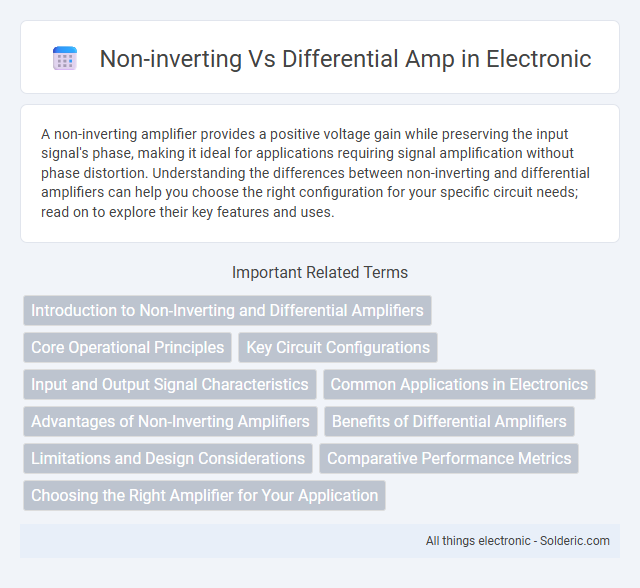A non-inverting amplifier provides a positive voltage gain while preserving the input signal's phase, making it ideal for applications requiring signal amplification without phase distortion. Understanding the differences between non-inverting and differential amplifiers can help you choose the right configuration for your specific circuit needs; read on to explore their key features and uses.
Comparison Table
| Feature | Non-Inverting Amplifier | Differential Amplifier |
|---|---|---|
| Input Configuration | Single input at the non-inverting terminal (+) | Two inputs; amplifies the difference between inverting (-) and non-inverting (+) terminals |
| Gain Formula | 1 + (Rf/Rin) | Rf/Rin (for matched resistors) |
| Output Signal | In-phase with input signal | Proportional to the voltage difference between two inputs |
| Common Mode Rejection Ratio (CMRR) | Typically low or negligible | High CMRR; rejects common-mode signals effectively |
| Applications | Signal buffering, impedance matching, simple gain stages | Sensor signal amplification, noise reduction, instrumentation |
| Input Impedance | High input impedance at non-inverting input | High input impedance at both inputs (depending on design) |
| Complexity | Simple circuit design | More complex, requires precise resistor matching |
Introduction to Non-Inverting and Differential Amplifiers
Non-inverting amplifiers provide output signals that maintain the same phase as the input, ideal for applications requiring signal preservation with gain. Differential amplifiers amplify the voltage difference between two input signals, offering superior noise rejection and precision in measurement systems. Your choice between these amplifiers depends on whether you need phase fidelity or differential signal processing for enhanced noise immunity.
Core Operational Principles
A non-inverting amplifier amplifies the input signal while maintaining its original polarity, using a single input terminal connected to the non-inverting input of the operational amplifier. In contrast, a differential amplifier amplifies the voltage difference between two input signals, rejecting any voltages common to both inputs, which is essential for noise reduction in sensor signal processing. Understanding these core operational principles helps optimize your circuit design for signal fidelity and noise immunity.
Key Circuit Configurations
Non-inverting amplifiers feature a single input connected to the non-inverting terminal of the operational amplifier, providing high input impedance and a voltage gain determined by the ratio of feedback resistors. Differential amplifiers utilize two inputs connected to both the inverting and non-inverting terminals, enabling the amplification of the voltage difference between these inputs while rejecting common-mode signals. The key circuit configuration of a differential amplifier involves matched resistor pairs to ensure accurate gain and common-mode rejection, contrasting with the simpler feedback loop in non-inverting amplifier designs.
Input and Output Signal Characteristics
Non-inverting amplifiers provide an output signal that is in phase with the input, maintaining the same polarity and offering high input impedance with low output impedance suitable for signal buffering. Differential amplifiers amplify the voltage difference between two input signals, rejecting common-mode noise and producing an output proportional to the difference, crucial for applications requiring precise differential signal processing. The input characteristics of non-inverting amps emphasize single-ended signals, while differential amps handle balanced inputs to enhance signal integrity in noisy environments.
Common Applications in Electronics
Non-inverting amplifiers are commonly used in sensor signal conditioning and audio amplification due to their high input impedance and low output impedance, which preserves signal integrity. Differential amplifiers are essential in instrumentation and data acquisition systems to reject common-mode noise and amplify the difference between two input signals, improving measurement accuracy. Both amplifier types are integral in operational amplifier circuits for precision electronics and communication systems.
Advantages of Non-Inverting Amplifiers
Non-inverting amplifiers provide high input impedance, making them ideal for sensor and signal buffering applications where minimal signal loading is critical. They offer a predictable voltage gain with a straightforward design, resulting in enhanced stability and reduced distortion compared to differential amplifiers. The ability to amplify signals without phase inversion ensures signal integrity in audio and instrumentation systems.
Benefits of Differential Amplifiers
Differential amplifiers provide superior noise rejection by amplifying the voltage difference between two input signals while suppressing common-mode noise, making them ideal for precision measurement applications. They offer higher input impedance and improved linearity compared to non-inverting amplifiers, enhancing signal fidelity and accuracy. Your circuits will benefit from their ability to handle small differential signals in noisy environments, ensuring reliable and accurate data acquisition.
Limitations and Design Considerations
Non-inverting amplifiers offer high input impedance and unity or greater gain but face bandwidth limitations as gain increases, and their output swing is constrained by the supply voltage. Differential amplifiers excel in rejecting common-mode signals and provide precise amplification of differential inputs, yet they require careful matching of resistors and layout to minimize offset errors and noise. Your design choice should weigh these factors against application requirements, balancing gain stability, input impedance, noise rejection, and power consumption.
Comparative Performance Metrics
Non-inverting amplifiers offer high input impedance and unity or greater gain with low distortion, making them ideal for buffering and signal conditioning, while differential amplifiers provide superior common-mode noise rejection and precise amplification of voltage differences, enhancing measurement accuracy in noisy environments. The gain accuracy in differential amps depends on resistor matching, often leading to more complex design requirements compared to the simpler gain set by feedback resistors in non-inverting amps. Noise performance favors differential amplifiers in applications requiring interference suppression, whereas non-inverting amplifiers excel in low-frequency, low-noise scenarios due to their straightforward topology.
Choosing the Right Amplifier for Your Application
Selecting the right amplifier between a non-inverting and a differential amplifier depends on signal requirements and noise rejection. Non-inverting amplifiers offer high input impedance and unity phase gain, ideal for signal buffering and voltage amplification without inverting the signal. Differential amplifiers excel in rejecting common-mode noise and amplifying the voltage difference between two inputs, making them suitable for sensor signal conditioning and instrumentation applications.
Non-inverting vs Differential amp Infographic

 solderic.com
solderic.com